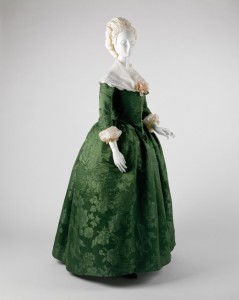When I’m having trouble focusing on cataloging our collection, promoting our special events, or pondering how to keep historic house museums relevant in the 21st century, I like to take my mind off such these weighty topics by doing some reading. And as if I needed any more encouragement, recently the Metropolitan Museum of Art launched a new site that makes many of their exhibition and collections catalogs available online. I’ve been busy ogling the pictures in several of the catalogs from the Costume Institute’s exhibitions featuring eighteenth century clothing. I highly recommend “The Ceaseless Century: Three Hundred Years of Eighteenth-Century Costume” and “Dangerous Liaisons: Fashion and Furniture in the Eighteenth Century.” And one of my favorite dresses of all time, an American roundgown from the 1770s, is featured in “Our New Clothes: Acquisitions of the 1990s.”

Silk damask round gown, made in America ca. 1775, from the collection of the Metropolitan Museum of Art
I have a busy day planned, but I may just have to make some time to start reading “The Eighteenth-Century Woman,” to learn more about the women who wore gowns like this…



